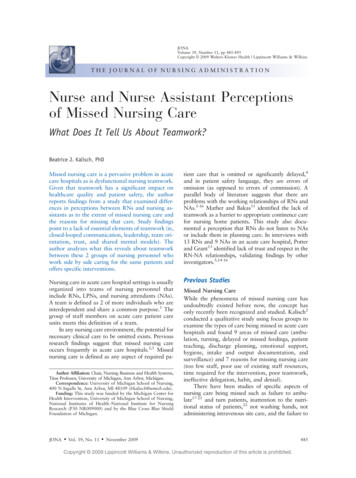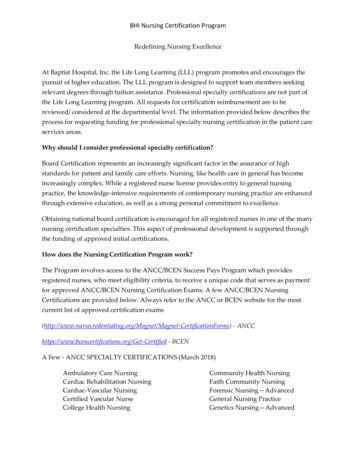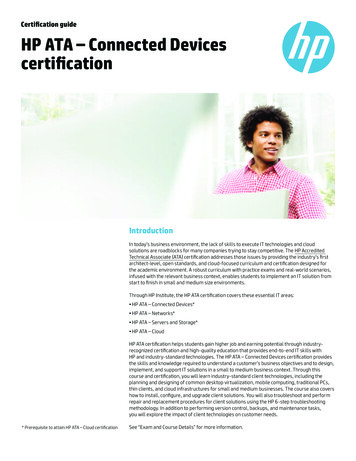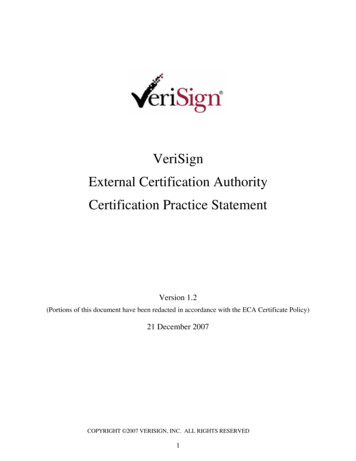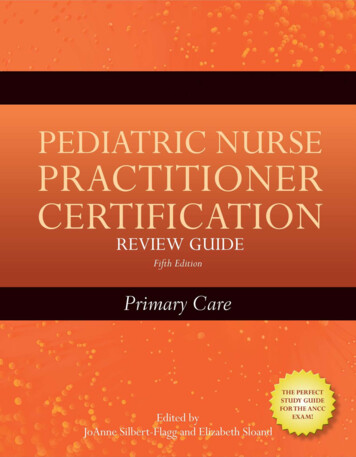
Transcription
PEDIATRIC NURSEPRACTITIONERCERTIFICATIONREVIEW GUIDEFifth EditionPrimary CareEdited byJoAnne Silbert-Flagg, DNP, CPNP, IBCLCAssistant ProfessorJohns Hopkins University School of NursingBaltimore, MarylandElizabeth Sloand, PhD, CRNPAssistant ProfessorCoordinator, Pediatric Nurse Practitioner TrackJohns Hopkins University School of NursingBaltimore, Maryland
World HeadquartersJones and Bartlett Publishers40 Tall Pine DriveSudbury, MA 01776978-443-5000info@jbpub.comwww.jbpub.comJones and Bartlett PublishersCanada6339 Ormindale WayMississauga, Ontario L5V 1J2CanadaJones and Bartlett PublishersInternationalBarb House, Barb MewsLondon W6 7PAUnited KingdomJones and Bartlett’s books and products are available through most bookstores and online booksellers. To contact Jones andBartlett Publishers directly, call 800-832-0034, fax 978-443-8000, or visit our website, www.jbpub.com.Substantial discounts on bulk quantities of Jones and Bartlett’s publications are available to corporations, professional associations, and other qualified organizations. For details and specific discount information, contact the special sales department atJones and Bartlett via the above contact information or send an email to specialsales@jbpub.com.Copyright 2011 by Jones and Bartlett Publishers, LLCAll rights reserved. No part of the material protected by this copyright may be reproduced or utilized in any form, electronic ormechanical, including photocopying, recording, or by any information storage and retrieval system, without written permissionfrom the copyright owner.The authors, editor, and publisher have made every effort to provide accurate information. However, they are not responsiblefor errors, omissions, or for any outcomes related to the use of the contents of this book and take no responsibility for the use ofthe products and procedures described. Treatments and side effects described in this book may not be applicable to all people;likewise, some people may require a dose or experience a side effect that is not described herein. Drugs and medical devices arediscussed that may have limited availability controlled by the Food and Drug Administration (FDA) for use only in a researchstudy or clinical trial. Research, clinical practice, and government regulations often change the accepted standard in this field.When consideration is being given to use of any drug in the clinical setting, the health care provider or reader is responsible fordetermining FDA status of the drug, reading the package insert, and reviewing prescribing information for the most up-to-daterecommendations on dose, precautions, and contraindications, and determining the appropriate usage for the product. This isespecially important in the case of drugs that are new or seldom used.Production CreditsPublisher: Kevin SullivanAcquisitions Editor: Amy SibleyAssociate Editor: Patricia DonnellyEditorial Assistant: Rachel ShusterProduction Editor: Amanda ClerkinMarketing Manager: Rebecca WasleyV.P., Manufacturing and Inventory Control: Therese ConnellComposition: Auburn Associates, Inc.Cover Design: Kristin E. ParkerCover Image: Hocusfocus/Dreamstime.comPrinting and Binding: Malloy, Inc.Cover Printing: Malloy, Inc.Library of Congress Cataloging-in-Publication DataPediatric nurse practitioner certification review guide : primary care. — 5th ed. / [edited by] JoAnne Silbert-Flagg and ElizabethSloand.p. ; cm.Rev. ed. of: Pediatric nurse practitioner certification review guide / editors, Virginia Layng Millonig, Caryl E. Mobley. 4th ed.c2004.Includes bibliographical references and index.ISBN-13: 978-0-7637-7598-8 (alk. paper)ISBN-10: 0-7637-7598-3 (alk. paper)1. Pediatric nursing—Outlines, syllabi, etc. 2. Examinations—Study guides. I. Silbert-Flagg, JoAnne. II. Sloand, Elizabeth. III.Millonig, Virginia Layng. Pediatric nurse practitioner.[DNLM: 1. Pediatric Nursing—Examination Questions. 2. Pediatric Nursing—Outlines. 3. Licensure, Nursing—standards—Examination Questions. 4. Licensure, Nursing—standards—Outlines. 5. Nurse Practitioners--Examination Questions. 6. NursePractitioners—Outlines. WY 18.2 P371b 2010]RJ242.P43 2010618.92 00231—dc2220090334086048Printed in the United States of America14 13 12 11 10 10 9 8 7 6 5 4 3 2 1
ContentsPrefaceviiiAcknowledgmentsAuthor NoteContributorsInfant Growth and Development 10Toddler and Preschooler Growth andDevelopment 13School-Aged Development 15Adolescent Development 16The Changing American Family as Contextfor Growth and Development 17Deviations in Physical Growth andBehavioral Development 18Health Supervision as OngoingSurveillance, Screening, and Assessmentof Physical Growth and BehavioralDevelopment 31Questions 32Answers 35Bibliography 35ixxxiChapter 1Test Taking Strategiesand Techniques 1Janice J. HoffmanSelf-Assessment Regarding SeekingCertification 1Know the Test Plan 2Develop a Specific Plan 2Approaches to Test Taking 2Maximizing Study Time 5Test Day 6References 6Chapter 2Human Growth and DevelopmentM. Elizabeth M.YoungerHuman Growth and Development:Underlying Theory and Science ofChild Health 77Chapter 3Health Promotion and Well ChildCare for Infants, Children, andAdolescents 37JoAnne Silbert-FlaggOverview: Health Maintenance and HealthPromotion 37Child Health Supervision 37The Pediatric History 38iii
ivContentsThe Pediatric Physical Examination 42Specific Normal Findings and CommonVariations 44Selected Laboratory Tests and Values 54Selected Screening Tests 57Special Examinations 59Problem-Oriented Health Record 62Child Health Supervision Schedule of Visitswith Key Issues (Nutrition, Development,Screening, Immunizations, AnticipatoryGuidance, and Health Education) 62Questions 77Answers 80Bibliography 80Chapter 4Eye, Ear, Nose, Mouth, and ThroatDisorders 81Karen K. BuchHead 81Eye 84Ear 96Nose 103Mouth 106Throat 110Questions 114Answers 117Bibliography 117Chapter 5Cardiovascular DisordersPeggy DorrAnswers 133Bibliography 134Chapter 6Lower Respiratory DisordersElizabeth SloandCroup (Laryngotracheobronchitis) 135Foreign Body Aspiration 136Bronchitis 137Bronchiolitis 137Pneumonia 138Cystic Fibrosis (CF) 140Asthma 142Bronchopulmonary Dysplasia (BPD) 144Apnea 146Tuberculosis (TB) 147Questions 149Answers 151Bibliography 151Chapter 7Dermatologic ConditionsJeanne Steman Findlay119Congenital Heart Disease/Defects 119Congestive Heart Failure (CHF) 120Murmurs 122Disturbances of Rate and Rhythm 123Hypertension 125Hypercholesterolemia 126Kawasaki Disease (Mucocutaneous LymphNode Syndrome) 127Acute Myocardial InflammatoryDisease 129Rheumatic Fever/Heart Disease 130Questions 132135153Newborn Exanthema 153Vascular Lesions 154Melanocyte Cell and PigmentationConditions 156Papulosquamous Conditions 159Dermatitis Conditions 161Burn Conditions 164Bacterial Conditions 166Bacterial Conditions InvolvingPilosebaceous Unit 168Viral Conditions 170Fungal Infections 172Insect Conditions 176Insect Infestations 179Miscellaneous Conditions ofHypersensitivity 181Questions 184Answers 190Reference Materials 191Bibliography 192
ContentsChapter 8Gastrointestinal DisordersLindsay Wilson193Gastroesophageal Reflux in Infancy(GER) 193Pyloric Stenosis 194Acute Infectious Gastroenteritis 195Pinworms (Enterobiasis vermicularis) 199Inflammatory Bowel Disease (IBD) 199Chronic Diarrhea 201Malabsorption 201Acute Abdominal Pain 202Functional Gastrointestinal Disorders 203Constipation 205Hepatitis 206Hernia 208Questions 208Answers 211Bibliography 211Chapter 9Infectious DiseasesJody K. Roblyer213Septicemia (Sepsis) 213Diphtheria 214Pertussis (Whooping Cough) 215Influenza 216Rubella (German Measles) 217Rubeola (Red measles) 218Roseola (Exanthem Subitum) 219Fifth Disease (Erythema Infectiosum–EI)219Varicella-Zoster Virus (VZV)(Chickenpox) 220Mumps 221Cat Scratch Disease (CSD) 222Rocky Mountain Spotted Fever(RMSF) 223Lyme Disease 223Infectious Mononucleosis (IM) 225Infant Botulism 226Poliomyelitis 226Tetanus (Lockjaw) 227Malaria 228Questions 229Answers 231Bibliography 231Chapter 10Musculoskeletal DisordersRachel Lyons233Torticollis (Wry Neck) 233Developmental Dysplasia of the Hip(DDH) 234Talipes Equinovarus Congenita(Clubfoot) 235Metatarsus Adductus/MetatarsusVarus 235Tibial Torsion (Internal) 236Genu Varum (Bowleg) 236Genu Valgum (Knock-Knee) 237Transient (Toxic) Synovitis of the Hip 237Legg-Calvé-Perthes Disease (LCPD) 238Growing Pains 238Osgood-Schlatter Disease 239Scoliosis (Idiopathic) 239Sports Injuries 240Slipped Capital Femoral Epiphysis 241Juvenile Idiopathic Arthritis 242Systemic Lupus Erythematosus 244Osteomyelitis 245Duchenne Muscular Dystrophy(DMD) 245Questions 246Answers 249Bibliography 249Chapter 11Neurological DisordersMaureen C. Maguire251Seizure Disorders/Epilepsy 251Febrile Seizures 255Headaches 255Neurofibromatosis (NF1) (vonRecklinghausen Disease) 257Tuberous Sclerosis (TS) 258Tic Disorders 258Head Injuries 260v
viContentsMeningitis 262Brain Tumors 263Questions 264Answers 267Bibliography 267Chapter 12Genitourinary/Gynecological Disorders/Adolescent Pregnancy 269Marlo A. Eldridge and MaryLou C.RosenblattUrinary Tract Infection (UTI) 269Enuresis 271Cryptorchidism (UndescendedTestes) 272Hydrocele 273Hypospadias 273Phimosis and Paraphimosis 274Meatal Stenosis 274Testicular Torsion 275Labial Adhesions (Labial Fusion, SynechiaVulvae, Labial Agglutination) 275Vulvovaginitis 276Dysmenorrhea 277Premenstrual Syndrome 278Genitourinary Trauma 279Glomerulonephritis (GN) 279Hydronephrosis 280Renal Tubular Acidosis (RTA) 280Sexually Transmitted Infections 281Contraception 288Issues of Pregnancy and Birth for theAdolescent 290Questions 293Answers 298Bibliography 298Chapter 13Hematologic/Oncologic/ImmunologicDisorders 299M. Elizabeth M. Younger and Kathy RubleABO Incompatibility 299Rh Incompatibility 299Neonatal HyperbilirubinemiaHemoglobinopathies 301300Iron Deficiency Anemia 302Sickle Cell Disease 303Lead Poisoning (Plumbism) 305Glucose-6-Phosphate Dehydrogenase(G-6-PD) deficiency 306Bleeding Disorders 307Cancers 310Immune Deficiencies 314Questions 316Answers 318Bibliography 318Chapter 14Endocrine DisordersMalinda D. Duke321Thyroid Disorders 321Pituitary Disorder—Diabetes Insipidus(DI) 326Growth Disturbances 328Adrenal Gland Disorders 332Miscellaneous 335Questions 344Answers 347Bibliography 347Educational Web Sites 348Chapter 15Multisystem and GeneticDisorders 349Rita Marie JohnIntroduction 349Congenital Diseases 350Genetic Syndromes 359Multisystem Disorders 366Questions 369Answers 371Bibliography 372Chapter 16Advanced Practice, Role Development,Current Trends, and HealthPolicy 373Janet S. SelwayIntroduction 373Advanced Practice Nursing373
ContentsPractice Issues 377Professional Organizations 382Health Policy 382Types of Healthcare Delivery Systems 384Health Insurance Portability andAccountability Act of 1996 (HIPPA) 386Questions 387Answers 390Bibliography 390Index393vii
Preface MatterFront/EndTitleWe are pleased to present the fifth edition of the Pediatric Nurse Practitioner Certification Review Guide fromJones and Bartlett Publishers. The book is a revisionof the 2004 text published by Health Leadership Associates, edited by Virginia Layng Millonig and Caryl Mobley. It has a dual purpose. The book serves pediatricnurse practitioner (PNP) and family nurse practitioner(FNP) graduates who are doing self-study preparationfor the PNP primary care certification exam. Studentsand graduates can be overwhelmed when faced withthe vast body of knowledge required for certification.This book brings together the most current and essential information in an organized, concise, and comprehensive manner. This book also serves as a valuableclinical resource for practicing PNPs and FNPs in pediatric primary care.The first chapter of the book reviews test-takingstrategies to help students plan their certification preparation, considers various approaches to test taking,and helps students organize their study time. The second chapter reviews growth and development; thethird chapter, which covers health promotion andwell child care for infants, children and adolescents,includes expanded information on the promotion ofbreastfeeding in the first year of life. The subsequentchapters of the book review the following systems:HEENT, cardiovascular, lower respiratory, dermatology, gastrointestinal, infectious diseases, musculoskeletal, neurological, GU and GYN (including adolescentpregnancy), hematologic/oncologic and immunologicviiidisorders, endocrine, and multisystem and genetic disorders. The book concludes with a chapter on advancedpractice nursing, role development, current trends, andhealth policy.Pediatric Nurse Practitioner Certification ReviewGuide) presents the most updated information andcurrent standards of practice for the NP in the pediatricprimary care setting. It examines all the content areasrequired for the certification examinations for PNPs inprimary care. Each system chapter presents commonpediatric disorders followed by a definition of the disorder and its etiology/incidence, signs and symptoms,differential diagnosis, physical findings, diagnostic tests,and management/treatment. Practice test questionsfollow content in each chapter. This format enables thereader to review essential information and to exploreareas that may require further study. Bibliographies andrelevant web sites give the reader resources for furtherdiscussion and study.All chapter authors are specialists in their areas. Clinical chapter authors are certified PNPs and expert clinicians who have practiced extensively in their specialtyarea. The editors are faculty members at the Johns Hopkins University School of Nursing in the PNP primarycare master’s degree program.We hope that this review guide assists the PNP graduate to become certified and to provide competent andcompassionate health care throughout their career tochildren, adolescents, and their families.
AcknowledgmentsWe are pleased to have had the opportunity to revisethe work of Virginia Layng Millonig and Caryl ErhardtMobley. We owe additional thanks to each chapter author for her diligence, knowledge, and expertise.We are grateful to our professional colleagues whohave mentored, supported, and taught us over theyears, particularly those at the Johns Hopkins University School of Nursing.JoAnne Silbert-Flagg and Elizabeth SloandAs a practicing PNP for over 20 years at ColumbiaMedical Practice in Columbia, Maryland, I have hadthe opportunity to provide pediatric primary care to ageneration of patients. I hope I have touched their livesas much as they have touched mine. Over the years,the pediatricians and PNPs in the practice have beena source of support and inspiration for me. I am especially indebted to R. Scott Strahlman, MD, a pediatricianin the practice, who agreed to be my preceptor duringthe residency portion of my DNP program at ColumbiaUniversity.I have been fortunate to have the support of my parents, Herbert and Betty Silbert, and my brother BrettSilbert. They have provided encouragement as I pursued my educational, professional, and personal goals.Lastly, and most importantly, I dedicate this book to mychildren, Christopher and Jennifer Flagg.JoAnne Silbert-FlaggI am personally indebted to my husband, Bob, whomakes everything possible; my children Daniel, Christine, Rachel, and Rosie, who are a continued source ofjoy and pride; and to my parents Dorothy and Josephfor their ever-present encouragement and love.Elizabeth Sloandix
Author NoteThe authors would like to thank and acknowledge thechapter authors from the fourth edition of this text.Chapter 9. Infectious Diseases: Nancy E. Kline, PhD, RN,CPNP, FAANChapter 1. Test Taking Strategies: Nancy A. DickensonHazard, MSN, RN, CPNP, FAAN and Virginia LayneMillonig, PhD, RN, CPNPChapter 10. Musculoskeletal Disorders: SusanHeighway, MS, RN, CS, PNPChapter 2. Human Growth and Development: Mary A.Baroni, PhD, RN, CPNPChapter 3. Health Promotion and Well Child Carefor Infants, Children, and Adolescents: BernadetteMazurek Melnyk, PhD, RN, CS, PNP and Leigh Small,PhD, RN, CPNPChapter 4. Head, Eye, Ear, Nose, Mouth, and ThroatDisorders: Connie Paczkowski, MSN, RN, CS, PNPChapter 5. Cardiovascular Disorders: Karen Uzark, PhD,RN, CPNPChapter 6. Lower Respiratory Disorders: Janet Johnston,MSN, RN, CPNPChapter 7. Dermatologic Conditions: Beverly Bigler,EdD, RN, CPNPChapter 8. Gastrointestinal Disorders: Victoria A. Weil,MSN, RN, CS, CPNPxChapter 11. Neurological Disorders: Susan Heighway,MS, RN, CS, PNPChapter 12. Genitourinary and Gynecological DisordersAdolescent Pregnancy: Sandra Elvik, MS, RN, CPNPand Mary A. Baroni, PhD, RN, CPNPChapter 13. Hematological/Oncologic/ImmunologicDisorders: Juanita Conkin Dale, PhD, RN, CPNPChapter 14. Endocrine Disorders: Jacalyn PeckDougherty, PhD, MA, MS, RN, CPNPChapter 15. Multisystem and Genetic Disorders:Alison W. Schultz, EdD, RN, CPNP and VirginiaRichardson, DNS, RN, CPNPChapter 16. Advanced Practice, Role Development,Current Trends, and Health Policy: Leeanne C. Busby,DSN, RN, CS, FAANP and Mary A. Baroni, PhD, RN,CPNP
ContributorsKaren K. Buch, RN, MSN, CPNPClinical InstructorJohns Hopkins UniversitySchool of NursingBaltimore, MarylandPeggy Dorr, MS, CRNPPediatric Nurse PractitionerDivision of Pediatric CardiologyUniversity of Maryland Medical CenterBaltimore, MarylandMalinda D. Duke, CPNP, CDEPediatric EndocrinologyJoslin Diabetes CenterUniversity of MarylandBaltimore, MarylandMarlo A. Eldridge, MSN, CPNPCo-DirectorVoiding Improvement Program of the Brady UrologicalInstituteJohns Hopkins HospitalBaltimore, MarylandJeanne Steman Findlay, CRNP, CCRPInstructorDepartment of DermatologyJohns Hopkins UniversitySchool of MedicineBaltimore, MarylandJanice J. Hoffman, PhD, RN, CCRNAssistant Professor and Vice ChairOrganizational Systems and Adult HealthUniversity of MarylandSchool of NursingBaltimore, MarylandRita Marie John, EdD, DNP, CPNPPediatric Nurse Practitioner/Neonatal NursePractitioner Program DirectorColumbia UniversitySchool of NursingNew York, New YorkRachel Lyons, DNP, CPNP-AC/PCAssistant Professor of Clinical NursingPediatric Orthopaedic SurgeryMorgan Stanley Children’s Hospital of New YorkPresbyterianColumbia UniversitySchool of NursingNew York, New YorkMaureen C. Maguire, MSN, RN, PNPAssistant ProfessorJohns Hopkins UniversitySchool of NursingBaltimore, MarylandJody K. Roblyer, MS, CRNP-PClinical InstructorJohns Hopkins UniversitySchool of NursingBaltimore, Marylandxi
xiiContributorsMaryLou C. Rosenblatt, RN, MS, CPNPLead Nurse Practitioner, Adolescent Medicine ClinicFaculty LEAH (Leadership Education in AdolescentHealth)Johns Hopkins HospitalBaltimore, MarylandLindsay Wilson, RN, MSN, CPNPPediatric Nurse PractitionerPediatric Gastroenterology and NutritionJohns Hopkins Children’s CenterJohns Hopkins HospitalBaltimore, MarylandKathy Ruble, PhD, RN, CPNP, AOCNDirector, Survivorship ProgramJohns Hopkins UniversityDepartment of OncologySchool of MedicineBaltimore, MarylandM. Elizabeth M. Younger, PhD, CPNPPediatric ImmunologyJohns Hopkins HospitalBaltimore, MarylandJanet S. Selway, DNSc, CRNPAdult/Pediatric Nurse PractitionerAssistant ProfessorUniversity of DelawareSchool of NursingNewark, Delaware
1Test Taking Strategiesand TechniquesJanice J. HoffmanThe decision has been made to take the certificationexamination, so it is now time to make plans. Basedupon prior experiences with standardized testingsituations, there may be some anxiety and questionsabout the certification process. This chapter includesan overview of the test plans for primary care pediatricnurse practitioner certification, followed by study andtest-taking strategies to assist in preparation for theexamination. SELF-ASSESSMENT REGARDINGSEEKING CERTIFICATIONThe first question that only the nurse contemplatingthe certification process can answer is: “Why do I wantto become certified as a pediatric nurse practitioner?”There are many benefits of professional certification,including demonstration of specialized knowledge an
CERTIFICATION REVIEW GUIDE Fifth Edition Primary Care. World Headquarters Jones and Bartlett Publishers . Cardiovascular Disorders 119 Peggy Dorr Congenital Heart Disease/Defects 119 Congestive Heart Failure (CHF) 120 . practice
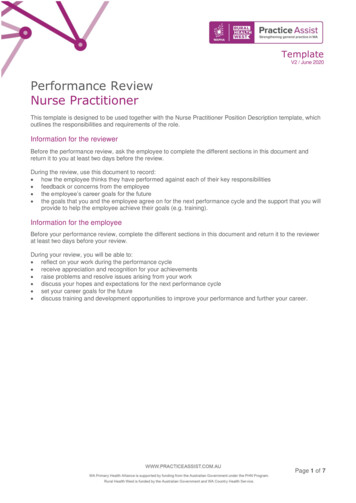
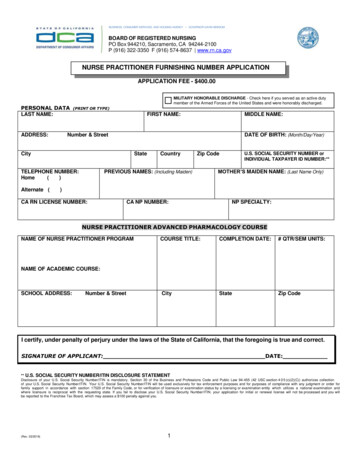
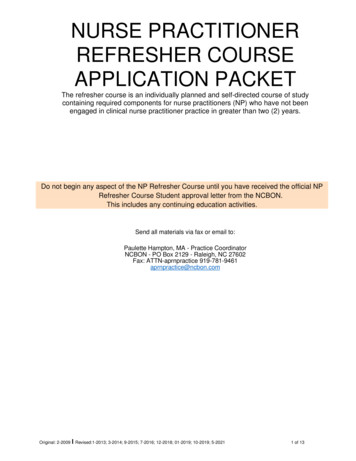
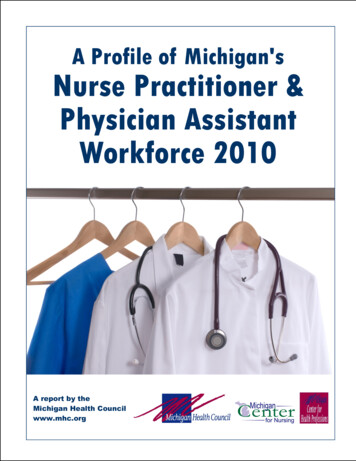
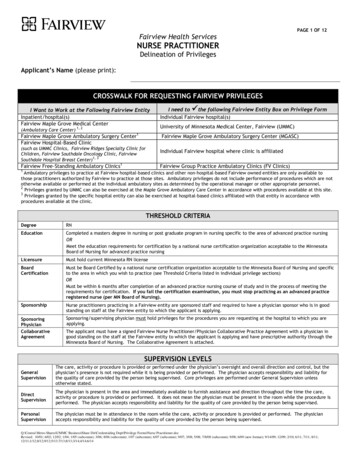
![Home Nurse Practitioner Program [Read-Only]](/img/11/smith-home-nurse-practitioner-program.jpg)
